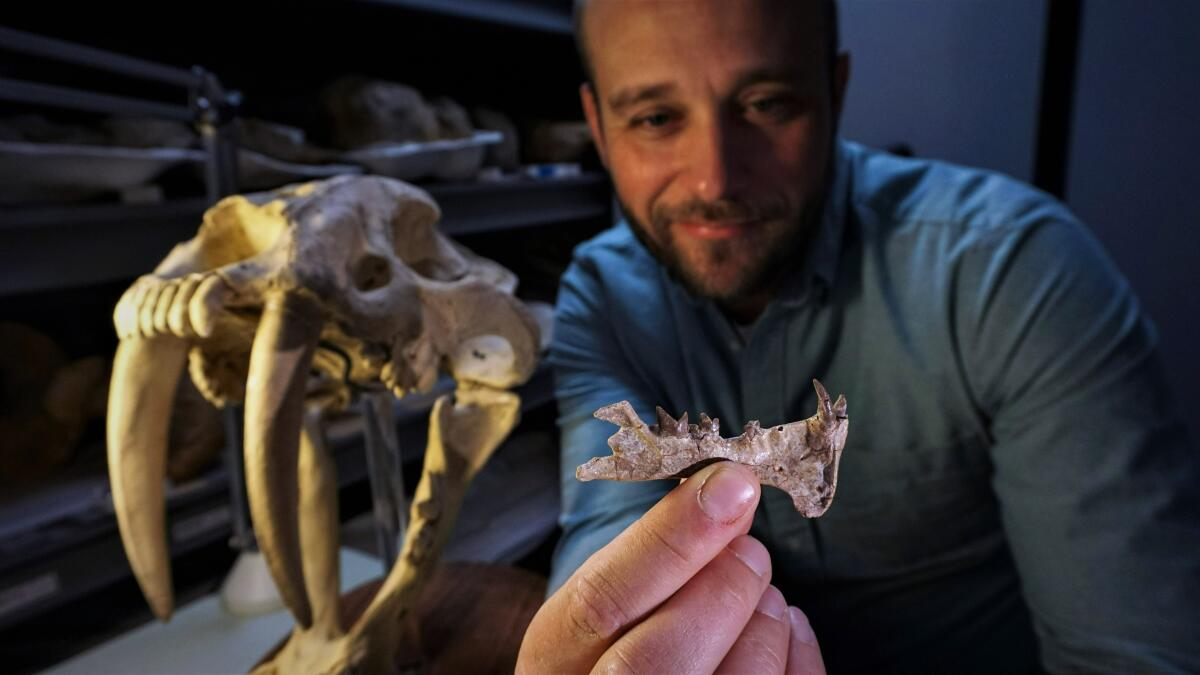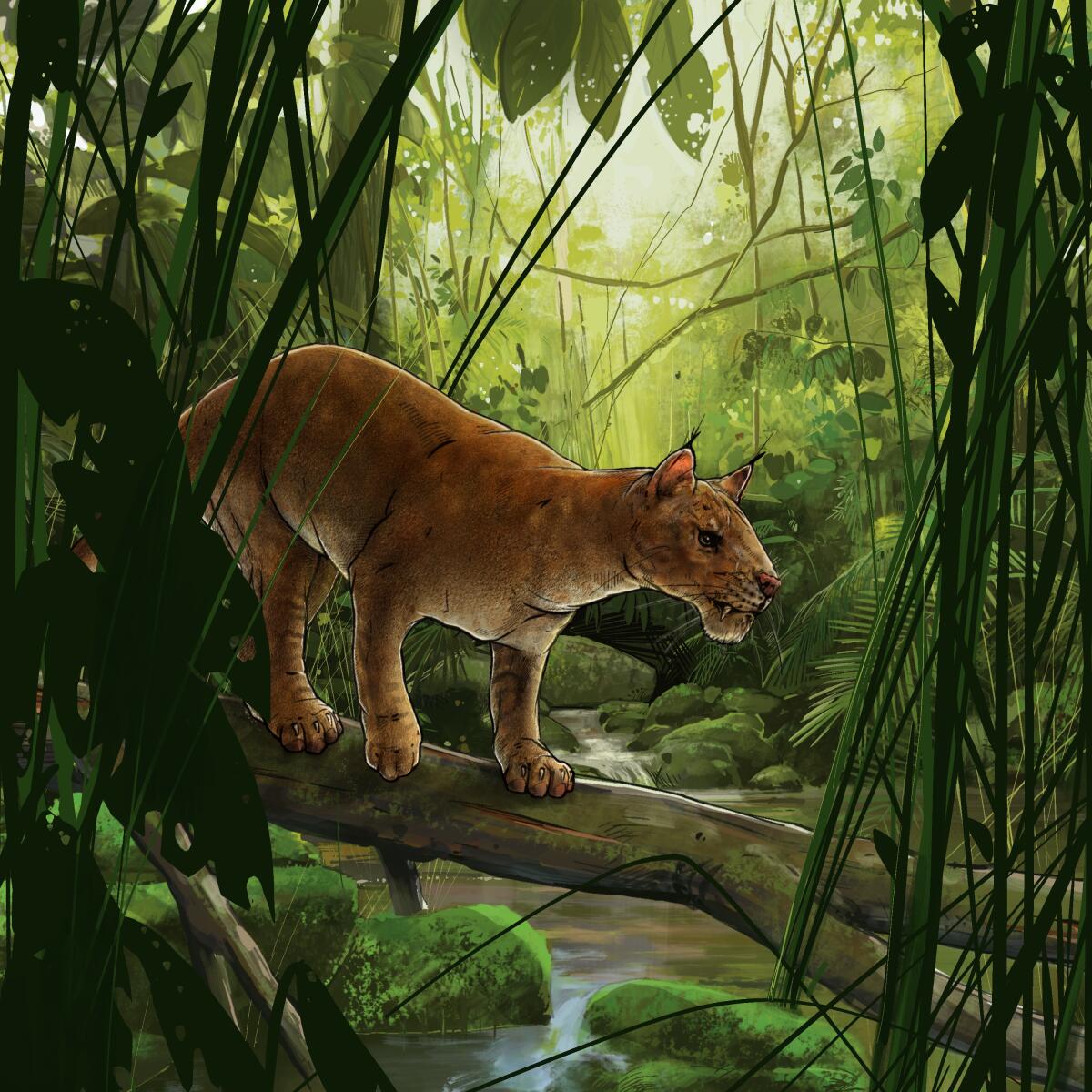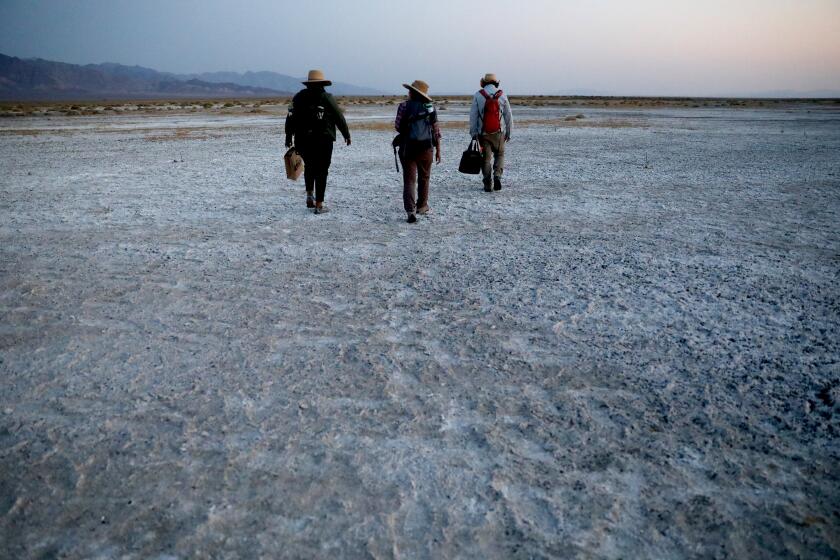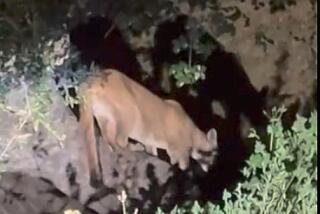Paleontologists discover new San Diego saber-toothed catlike species

- Share via
SAN DIEGO — A newly discovered saber-toothed catlike predator that hunted in the forests and coastal areas of this region 42 million years ago has been given the name Diegoaelurus, or “San Diego’s cat,” the San Diego Natural History Museum announced Tuesday.
The discovery of Diegoaelurus — which is now the earliest known cat-like predator in North America west of the Rocky Mountains — was unveiled in PeerJ, an international open-access science journal. The discovery was described in a research paper co-written by Ashley Poust, the museum’s postdoctoral researcher, Shawn Zack at the University of Arizona College of Medicine and fellow San Diego Nat paleontologist Hugh Wagner, who gave the new species its name.
The lower jaw and several teeth, including a long canine, were discovered in Oceanside in 1988 and had been stored in the museum’s vast fossil collection since. Wagner had done some initial research on the fossils in the late 1990s but moved on to other projects. When the pandemic hit in 2020, closing research institutions nationwide, Poust began collaborating online with Zack and Wagner, using 3-D modeling technology to confirm that these fossils were indeed a new species unique to the San Diego County region.
San Diego Natural History Museum visitors may have seen exhibits featuring Smilodon, a large saber-toothed cat that roamed North America during the Pleistocene era, about 10,000 years ago. By comparison, the far-more-ancient Diegoaelurus was much smaller, about the size of a bobcat, and similar in style to the fossa of Madagascar, a cousin to the mongoose, Poust said.

Poust said Diegoaelurus is a significant discovery because it is one of the first known instances of a “hypercarnivory” mammal, which had evolved to have only saber-toothed fangs and serrated scissor-like teeth in the back of its mouth. With no flattened molars to crush plants, seeds or insects, Diegoaelurus was built to survive on flesh and only flesh.
“Today the ability to eat an all-meat diet ... isn’t uncommon. Tigers do it, polar bears can do it. If you have a house cat, you may even have a hypercarnivore at home,” Poust said. “But 42 million years ago, mammals were only just figuring out how to survive on meat alone. One big advance was to evolve specialized teeth for slicing flesh, which is something we see in this newly described specimen.”
As the Earth warms and the drought deepens, a network of biologists and conservationists are racing to rescue California’s most threatened species.
“Nothing like this had existed in mammals before,” he said. “A few mammal ancestors had long fangs, but Diegoaelurus and its few relatives represent the first catlike approach to an all-meat diet, with saber-teeth in front and slicing scissor teeth called carnassials in the back. It’s a potent combination that several animal groups have independently evolved in the millions of years since.”
Diegoaelurus is part of a mysterious group of extinct animals called Machaeroidines, which are the oldest group of saber-toothed mammals. It’s possible the Diegoaelurus lived at the same time as similar North American species including the nimravids, or saber-toothed false cats. More research will be needed to find connections between these other species, whose fossilized bones have been found in Utah, Wyoming and parts of Asia.

Diegoaelurus comes from the Eocene epoch, which stretched from 56 million to 34 million years ago. The region had a tropical rainforest-like climate and was vastly different geologically than today.
Poust said that in Eocene times, the San Andreas Fault hadn’t yet begun shifting the Pacific and North American plates, so Baja California was still attached to mainland Mexico and the land mass that is now San Diego would have been farther south. Because the southernmost Sierra Nevada mountains would have been much taller in those days — “like Andes tall,” Poust joked — the region that’s now San Diego would have been a vast floodplain covered with dense rainforests where creatures resembling lemurs, tapirs and miniature rhinos roamed. They would have all been prey for the Diegoaelurus.
“It would have been a serious predator ... with a Swiss army knife of a mouth,” Poust said.
In 1988, construction crews widening Interstate 5 in Oceanside inadvertently uncovered a cache of fossils that was later discovered by a local 12-year-old boy named Jeff. Since then, “Jeff’s Discovery Site” has become an important fossil bed within a larger group of rocks called the Santiago Formation. In the years since, further road construction work has exposed more of these rocks, and fossils of an entire ecosystem have been discovered there, including the Diegoaelurus bones.
Back in the 1990s, Wagner studied these fossils and presented a lecture on how he believed they might be a new machaeroidine family known as Oxyaenidae. But he moved on to other projects. When the pandemic shut down Poust’s research in 2020, one of his paleontologist friends at UC Berkeley, Susumu Tomiya, suggested he search the museum’s collection for the fossils Wagner had written about years ago. Poust contacted Zack, who’s an international expert in ancient carnivores, and they were able to compare notes and 3-D models of similar discoveries via online conferencing.
The Diegoaelurus is the third major scientific discovery that Poust has made in the field of paleontology. He discovered a feathered dinosaur in China called the Wulong bohaiensis (“dancing dragon”) from 120 million years ago. He also published a paper on the fossil of a dinosaur with unlaid eggs still inside its skeleton, a rare opportunity to learn about oviraptorosaurs from the Cretaceous period.
Poust, 36, was born in the Bay Area, grew up in the Midwest and was studying English, theater and photography at a small liberal arts school in Illinois when he saw a poster for a summer geology expedition in the Rocky Mountains. The second he landed in the field and saw the stories that were hidden in the rocks, he was hooked.
“It changed the world around me,” he said. “I was into lit and theater and it told a story, but I realized that every bit of the land was telling me stories.”
His primary focus now is studying how and why animals evolve to adapt to their environments. That was what attracted him to join the museum’s paleontology team in 2019. The Balboa Park museum has a world-class collection of marine mammal fossils of ancient whales, seals, sea lions and walruses. Poust hopes to study how these species evolved along coastal California over millions of years.
“I’m trying to understand how weird new worlds get created and how does a group of animals’ growth and development contribute to that,” he said.
The full name of the new discovery is Diegoaelurus vanvalkenburghae. The first name honors the location of discovery, the second is for scientist Blaire Van Valkenburgh, past president of the Society of Vertebrate Paleontology, whose foundational work on the evolution of carnivores influenced this research.
More to Read
Sign up for Essential California
The most important California stories and recommendations in your inbox every morning.
You may occasionally receive promotional content from the Los Angeles Times.












